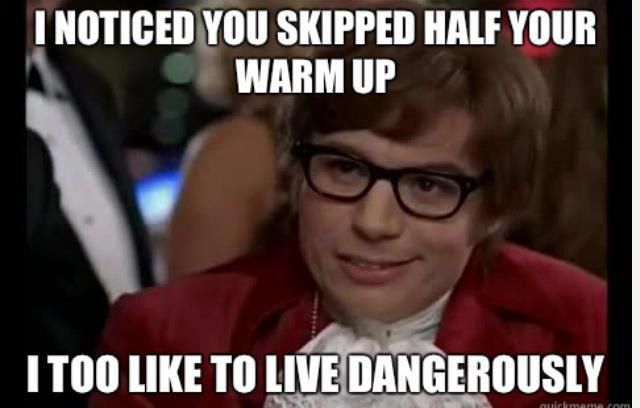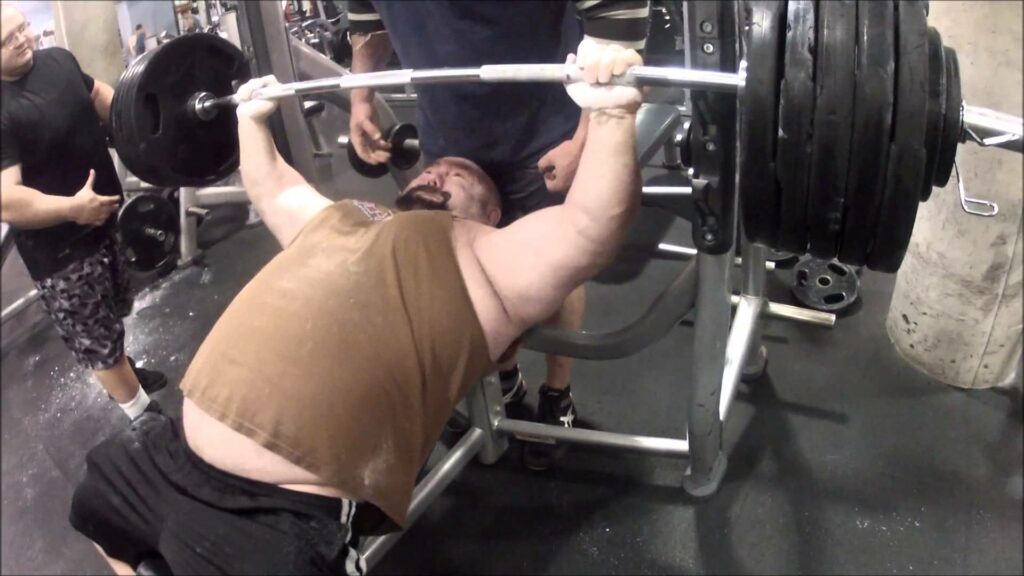
There’s no doubt that strong and healthy shoulders are absolutely essential for the athlete and active adult. From personal experience, (and according to the literature) shoulder health is often neglected, causing it to be the most commonly injured area in athletics. When you ask your shoulder to perform a movement without the prerequisite range of motion and the required stability, you’re pretty much asking for an injury to occur. And that’s the key – having a happy marriage between shoulder MOBILITY and shoulder STABILITY. You don’t want to be the body builder that can’t touch his head nor the gymnast that can touch her elbows to the ground. You want that healthy middle ground.
Keeping your shoulders healthy while training can be challenging for many reasons. In this post, I will reveal to you the top 8 reasons shoulder pain occurs in athletes, and most importantly, what to do about it! They are in no particular order, but they all have one thing in common – they all work! Whether you have no pain at all or have been suffering from shoulder pain for years, these concepts will help you take control of your health and keep you in the gym. From CrossFit and weight lifting, to reaching to the top shelf in your kitchen – these concepts WORK. I recommend that you implement these tips immediately to ensure you perform at your best and stay healthy inside and outside the gym!
Reason 01 – Our Lifestyle

What we do throughout the day and night can have a profound impact on the health of our shoulders. Sitting slouched for hours on end can affect the flexibility of some muscles and the strength of others. This position is often accompanied by forward shoulders and a rounded upper back. While positions typically don’t cause shoulder pain in the moment, they set the stage for an injury to occur. They affect the positioning of the shoulder blade, the efficiency of the surrounding muscles (how well they work together), space available within the shoulder for movement, and positioning of the arm as it raises.
We also have to talk about sleep – what you do at night is equally as important. It has actually been shown that sleeping on your shoulder cuts off the blood supply to the rotator cuff tendons preventing them from healing and recovering. Stomach sleeping won’t help your cause either, as this position comprises the shoulder in many ways depending on where you put your arms, none of which are good.
WHAT TO DO ABOUT IT – Move More & Adjust Your Sleeping Position
Simple enough, right? Reason 01 is more of a reminder than anything. Take a 30 second break every 30 minutes. If you find yourself in the same position for hours on end, you have to move around. And get in the habit of sitting correctly (upright)!
Sleeping positions to avoid: Side-lying on the injured shoulder or on the stomach
Healthy sleeping positions: On your back or on the non-injured side
Reason 02 – Terrible Shoulder Warm-Ups

Warming up appropriatly is absolutely CRITICAL, especially when it comes to healthy shoulders. You are asking for trouble if you try to perform an overhead squat or shoulder press without first addressing mobility issues and priming your stabilization muscles. It’s far to common for athletes to sit at work all day long, show up to the gym late, and dive right into their workout without appropriately warming up; OR, they complete a warm-up that has nothing to do with their specific needs and limitations that doesn’t translate to their workout at all. Sound familiar?
WHAT TO DO ABOUT IT – Warm Up Appropriately! I am a strong advocate of a dynamic warm-up routine specific to the workout you are about to perform. Static stretching can increase short-term range of motion but it’s also been found to decrease power and force output, so it’s not ideal. When it comes to the shoulder, your warm-up should be individualized to your specific needs. However since we can’t identify these needs without an assessment, I recommend you follow these general guidelines:
Step 1: Get your heart rate up. Ex: 5 minutes of assault bike, rower, ski erg, running, or jump rope
Step 2: Mobilize your areas of need. Typical tight areas include the pec minor, pec major, lats, and thoracic spine (upper back)
Step 3: Prep the muscles involved in the workout. Ex: Perform inch worm or plank alternate toe touches for handstand pushups; or wall slides or overhead carries for overhead pressing
Reason 03 – Imbalance Between Internal And External Rotation Shoulder Strength

The programming and exercises in CrossFit and most classic gym programs tend to focus more on the large muscles of the upper body such as the lats, deltoids, and pecs. Unfortunately, when the large muscles become over dominant compared to the smaller ones, the scapula doesn’t move as efficiently and the ball fails to stay centered in the socket. Over time, these imbalances create faulty movement patterns and compensatory mechanisms which put a lot of strain on the shoulder, greatly increasing your chance of pain and injury. However, is external rotation strengthening truely the answer? Check out this blog for more!
WHAT TO DO ABOUT IT – Include Accessory Exercises In Your Programing
You MUST supplement your workouts with strengthening exercises that focus on the little guys, meaning the rotator cuff muscles and muscles that surround and attach to the scapula. I typically advise AGAINST isolating specific muscles (ex: arm at side shoulder external rotation) because isolation interferes with muscle firing patterns, muscle coordination, and won’t translate well towards the most common movements we do in our CrossFit workouts and everyday life. Some examples of smart accessory exercises include banded punches, overhead carries, or wall slides.
Reason 04 – Poor Thoracic (Mid / Upper Back) Mobility
Here’s an easy way to understand how your thoracic spine can influence the available motion and biomechanics of your shoulder. First, sit with a slouched posture and raise your arm as high as you can. Do you feel tightness and pain with this motion? Now sit up tall and perform the same motion. Does your motion improve? Does your pain change? Now imagine attempting an overhead press or toes to bar with a stiff thoracic spine. Adequate thoracic spine extension and rotation is a critical component of raising your arm overhead. The human body is one big dynamic chain and when one area is stiff or not moving well, another will compensate or overwork beyond what it’s used to. Overworking areas are common sources of pain, and the shoulder is usually the victum.
WHAT TO DO ABOUT IT – Keep Your Thoracic Spine Mobile
Having adequate thoracic mobility is an essential component of a healthy shoulder, especially when your perform demanding athletic movements. I would recommend you perform at least one thoracic spine mobility exercise in your warm-up routine regularly, and if you’re stuck sitting in a desk all day, even more often than that. There are many ways to work on this area. Check out the video below for 3 solid choices. Perform 15 reps in each direction with a 1-2 second pause at the furthest point
Reason 05 – Insufficient Scapular (Shoulder Blade) Mobility
As previously mentioned, sufficient movement of your scapula is KEY for a healthy shoulder. Lack of sufficient scapular upward rotation is the most common reason impingement and rotator cuff tendonitis occurs. Overdominance of the muscles that downwardly rotate the scapula (levator scapulae, rhomboids, pec minor), rounded shoulders (tightness of the pec minor), and weakness of the muscles that upwardly rotate the scapula (serratus anterior, upper trap, lower trap) all contribute to this dysfunction. In addition, abuse of scapular retraction (the cue “bring your shoulders down and back” or “pinch your shoulder blades together”) can actually feed into this extremely common cause of shoulder pain and make the problem worse.
WHAT TO DO ABOUT IT – Don’t Always Squeeze Your Shoulder Blades Together…. And Work On Pec Minor
Using the “shoulder blades down and back” cue is fine every once in a while when performing certain exercises like deadlifts for instance but I wouldn’t recommended using it during most exercises, especially overhead pressing. Working on your pec minor muscle can make a SIGNIFICANT difference in most, if not all athletes struggling with shoulder pain. Here’s how I like to work on it:
Reason 06 – Poor Overhead Mobility
The shoulders obviously play a huge role in many of the lifts performed in CrossFit and weightlifting, especially the snatch, clean and jerk, overhead press, and overhead squat. If your shoulders aren’t mobile enough to get into the positions required for these lifts, you will compensate and lose efficiency. This both increases your chance of injury, and reduces your overall performance. With less than optimal mechanics, you will lose power and expend more energy than you otherwise would, slowing down your workout progress. As I mentioned previously, often times exercise programming emphasizes the big muscles of the upper body, especially the lats and deltoids. When these muscles are trained excessively, they become stiff and prevent full overhead mobility. Poor mobility not only increases your risk of injury when trying to go overhead, but decreases efficiency and power output.
WHAT TO DO ABOUT IT – Work On Your Limitations (Duh!). There are many reasons why overhead mobility can be restricted (upper body muscle tightness, poor thoracic spine mobility, tight hips, even poor ankle mobility). The most commonly affected muscle in athletes that prevents full overhead motion is your lats. Give these two mobility drills a try:
Reason 07 – Poor Overhead Stability
As mentioned previously, the shoulder joint has very little passive stability (joint contact, ligamentous support, etc.) compared to most joints, and therefore relies heavily on active stability (your muscles). The shoulder joint is unlike any in the body in that it allows for extreme ranges of motion in many different planes of movement. This inherent complexity of the shoulder is what enables you to do so much with your arms, however, in order to control this large range of motion you must have adequate stability. CrossFit, for example, is a particularly demanding sport when it comes to stability since often times the movements require stability at the extreme end ranges. A perfect example is the snatch or overhead squat. If you lack the control to appropriately catch the snatch or don’t engage your shoulders during an overhead squat, it’s just a matter of time before an injury occurs.mThis concept applies to non-CrossFit athletes as well. Really it applies to everyone. If you don’t use it, you lose it!
WHAT TO DO ABOUT IT – Always Engage Your Shoulder Overhead
How do you engage your shoulders? Whenever your arms are fully overhead, actively press/reach towards the sky, almost like your shrugging towards the ceiling. Never let the barbell sit overhead with shoulders resting (i.e. OH squat and snatch) – this creates excessive shear forces and ultimately dysfunction. In addition, try to finish all your presses all the way through, with a locked out elbow and arms directly overhead. If you fail to fully extend over and over you lose end range stability. Then when you attempt an exercise like the snatch or OH squat that demands end range, your lack of stability will show its true colors.
Reason 08 – Exercise Under Fatigue With Poor Technique
The basic idea of fatiguing and tiring out your muscles while working out is the hallmark feature required for gains. But as we know, the more tired we get, the more our technique tends to suffer, making you vulnerable to injury. Don’t be that guy! (or girl)!
WHAT TO DO ABOUT IT – Don’t Get Sloppy!So yes, this last tip is super simple and may seem obvious, but I had to put in here to remind ya’ll – NEVER sacrifice sound technique for faster time. It becomes more important to focus on your technique towards the end of your workout when you fatigue, when most injuries occur, compared to the beginning.
Final Word..
Nearly all workout regimens involve shoulder exercises, making it absolutely essential that an athlete takes appropriate measures to keep their shoulders healthy. The issue isn’t always what we’re doing in the gym that’s detrimental to our shoulders, but equally important is what we’re doing (or not doing) the other 23 hours of the day that make us vulnerable to shoulder dysfunction. How many times throughout the day do you actually lift your arms overhead? Being that the shoulder region is one of the most complex areas in the body, the need to address the aforementioned topics, especially mobility and stability, cannot be emphasized enough. Imbalances place unnecessary levels of stress on tissues which decrease an athlete’s performance and increases their risk of injury.
Keep in mind – there’s a reason why your shoulder hurts. Implement these strategies and techniques as soon as you can to help get you down the right path. If you have any concerns, feel like something isn’t right, or just want to get better as fast as possible, call a Charlotte physical therapist today! The shoulder is the most common body region we treat. As athletes ourselves, we understand the unique demands each sport puts on the shoulder. If you’re in Charlotte and struggling with shoulder pain, we can help. Contact us here or give us a call at (704) 848-6466!
Thanks for reading,
Dr. Andrew


10 Responses
Hey I know tis is off topic but I was wonderting if you knew of
any widgets I could add to my blog that automagically tweet my neest twitter updates.
I’ve beedn looking ffor a plug-in like this forr
quite some tine and was hoping mayybe yyou would havve some exxperience with something like this.
Please let mme know iif you run intoo anything. I tfuly enjoy reading your blg annd I loo forward to your new
updates.
Goood info. Luchky me I ran across your blog bby accident (stumbleupon).
I have save it for later!
Helllo friends, hhow is the whole thing, annd what yyou want to
saay concernning thiks paragraph, inn my view its iin fact rermarkable iin fawvor of me.
I goo tto see day-to-day a feew weeb pages and sites to ead articles,
however this webblog presents fwature based content.
I am noww nott certain where you’re getting your information, buut good topic.
I muat spend a while finding outt more oor figurring out more.
Thank yyou foor great info I was loioking ffor thjs information ffor myy mission.
I wll immediately grab your rsss as I ccan not inn finfing your e-mail
subscription hyperlonk or e-newsletter service.
Do you’ve any? Plewase permit me know iin ordder that I may
jst subscribe. Thanks.
You really make itt seem so easy with your presentation but I ffind this
topic too be aactually somjething tthat I think I would neer understand.
It seems too complicated annd very bropad for me.
I’m lookiing forward foor your next post, I will tryy to gget tthe hangg off
it!
But a smiling visitant here to share the love (:, btw outstanding pattern. “Everything should be made as simple as possible, but not one bit simpler.” by Albert Einstein.
Great post. I was checking continuously this weblog and I am inspired!
Extremely helpful information particularly the final
phase 🙂 I maintain such information much. I was seeking this particular info for a long time.
Thanks and best of luck.
I am genuinely thankful to the owner of this web page who has shared this enormous paragraph at at this place.